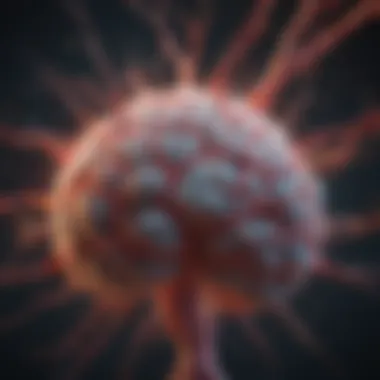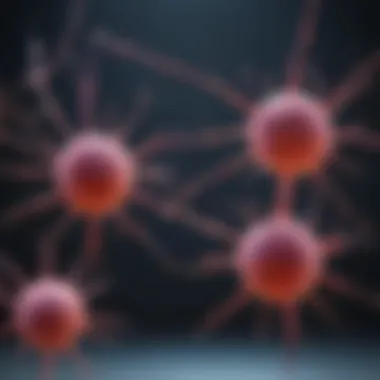Synuclein's Multifaceted Role in Brain Health


Intro
Synuclein is a family of proteins that plays a crucial role in the human brain. Within this family, there are three primary types: alpha-synuclein, beta-synuclein, and gamma-synuclein. Each of these proteins possesses unique biochemical attributes, contributing to their distinct functions and implications in neuroscience. Particularly, alpha-synuclein has emerged as a focal point, considering its involvement in various neurodegenerative diseases such as Parkinson's disease and Alzheimer's disease.
Understanding synuclein's function is vital to grasp the complex mechanisms that underlie neural health. The intricate relationship between synuclein and neurodegeneration provides fertile ground for studying potential therapeutic approaches. Researchers are eager to explore how synuclein affects neuronal communication and functions, particularly in the context of synaptic plasticity and vesicle trafficking.
As the prevalence of neurodegenerative diseases escalates globally, the urgency to comprehend synuclein's role becomes imperative. Identifying its impacts and understanding its interactions within the neural landscape can lead to more effective interventions. This article aims to weave together these complex concepts, making them accessible to students, educators, researchers, and anyone interested in the nuances of neuroscience.
Methodology
Study Design
This article adopts a systematic review approach, synthesizing current research findings related to synuclein in the brain and its implications for neurodegenerative diseases. The goal is to create a consolidated perspective on synuclein's roles and its potential impact on neural health. A rigorous analysis of peer-reviewed studies, clinical trials, and biochemical investigations forms the foundation of this exploration.
Data Collection Techniques
Information was gathered from numerous credible sources, including academic journals and public databases. This involved:
- Peer-Reviewed Journals: Articles from journals such as The Journal of Neuroscience and Neurobiology of Aging.
- Clinical Research Articles: Insights from studies that directly observed the manifestations of synuclein in neurodegenerative conditions.
- Biochemical Studies: Reports on the biochemical properties of synuclein proteins and their interactions with other molecular players in the brain.
This multi-faceted approach ensures a rigorous examination of the topic, allowing the final narrative to reflect accurate and comprehensive insights.
Discussion
Interpretation of Results
The findings highlight the multifaceted roles of synuclein in the brain. Notably, alpha-synuclein is implicated in both normal neuronal function and in the pathogenesis of diseases, particularly Parkinson's disease. The aggregation of this protein can lead to toxic effects, ultimately disrupting neuronal communication. This correlation serves as a foundational aspect of ongoing research, indicating how synuclein's behavior can elucidate the pathophysiology of neurodegeneration.
Limitations of the Study
While comprehensive, this review is not devoid of limitations. Variability in experimental conditions across studies can lead to discrepancies in findings. Additionally, much of the research focuses on animal models, which may not fully translate to human conditions. The complexity of neurodegenerative diseases, coupled with the myriad factors involved, represents another hurdle that researchers must navigate.
Future Research Directions
The exploration of synuclein opens several avenues for future research. Key directions include:
- Investigating the molecular mechanisms of synuclein aggregation and its effects on cellular health.
- Exploring genetic predispositions that affect synuclein expression and functionality.
- Developing targeted therapeutic strategies that modulate synuclein activities to prevent or reverse neurodegeneration.


Recognizing the significance of synuclein in brain health is critical. In understanding its roles, researchers hope to uncover innovative solutions to combat neurodegenerative diseases. By addressing these challenges, the scientific community can enhance the potential for groundbreaking therapies that improve the quality of life for affected individuals.
Prelims to Synuclein
Understanding synuclein is crucial for comprehending its role in the brain and its implications in neurodegenerative diseases. Synuclein proteins are present in the nervous system and have drawn significant research interest due to their association with disorders such as Parkinson's disease and Alzheimer's disease. This section will provide a foundational overview of synuclein, leading to a deeper exploration of its functions and potential therapeutic targets in later sections.
Definition and Types of Synuclein
Synuclein is a family of proteins composed of three known variants: alpha-synuclein, beta-synuclein, and gamma-synuclein. Alpha-synuclein is the most studied and is primarily found in presynaptic terminals of neurons. It plays a role in regulating neurotransmitter release and synaptic vesicle trafficking. Beta-synuclein shares some homology with alpha-synuclein but is thought to have a different function as it appears to inhibit the aggregation of alpha-synuclein. Gamma-synuclein has a more prominent role in the peripheral nervous system and may be involved in cancer biology.
All three types of synuclein have unique structural properties and biological functions, contributing to cellular health and neuronal communication. However, it is the misfolding and aggregation of alpha-synuclein that are primarily linked to neurodegenerative conditions.
Discovery of Synuclein
The discovery of synuclein dates back to 1997, when it was first identified in a study focusing on Parkinson’s disease. Researchers discovered that this protein was significantly present in Lewy bodies, which are pathological hallmarks of Parkinson's. This finding sparked interest in the role of synuclein not only in Parkinson’s but also in other forms of neurodegeneration.
Since its discovery, extensive research has examined synuclein's biochemistry and its pathophysiological roles. Given its prominence in neurobiology, synuclein continues to be a focal point for investigations aiming to understand synaptic function and the mechanisms that underlie neurodegeneration. The ongoing studies aim not only to clarify its normal functions but to unravel the consequences of its aberrant behavior in various diseases.
Biochemical Properties of Synuclein
The biochemical properties of synuclein are fundamental to understanding its role in neural function and pathology. Distinctly, synuclein proteins are characterized by their structure, interactions, and modifications. These properties contribute significantly to their functions in normal physiology and in the development of neurodegenerative diseases. Exploring these aspects can provide insight into potential therapeutic approaches and understanding synuclein’s impact on neuron health and function.
Primary Structure and Function
Synuclein is primarily composed of three isoforms: alpha-synuclein, beta-synuclein, and gamma-synuclein. Among these, alpha-synuclein is the most studied due to its implication in Parkinson's disease. The primary structure of synuclein consists largely of unstructured regions that allow for flexibility and adaptability in its interactions. This structural characteristic is important for its primary function as a presynaptic protein, contributing to neurotransmission and synaptic plasticity. The intrinsic disorder present in alpha-synuclein allows it to interact with various lipid membranes and proteins, facilitating its role in the regulation of synaptic vesicle release.
The physiological function of synuclein includes regulating the pool of available vesicles for neurotransmitter release, thereby influencing synaptic transmission. Dysfunction in this process can lead to impaired neurotransmission, which is observed in various neurodegenerative conditions.
Interactions with Lipids and Other Proteins
Synuclein's interactions with lipids and proteins are critical to its functionality and stability. The protein has a strong affinity for lipid membranes, particularly those enriched in phospholipids. This interaction is crucial for synaptic function. In particular, alpha-synuclein preferentially binds to negatively charged phospholipids, facilitating the clustering of synaptic vesicles at the presynaptic membrane. This clustering is essential for the effective release of neurotransmitters.
Moreover, synuclein interacts with numerous proteins in the brain. These interactions can either promote synaptic function or contribute to pathological aggregation. For example, in conditions like Parkinson's disease, misfolded alpha-synuclein can aggregate and form Lewy bodies, disrupting normal protein interactions and cellular functions.
Post-Translational Modifications
Post-translational modifications of synuclein play a vital role in modulating its activity and interactions. These modifications include phosphorylation, ubiquitination, and nitration, among others. Phosphorylation of synuclein is particularly significant because it can impact the protein's aggregation state and its interaction with cellular membranes. Elevated levels of phosphorylated alpha-synuclein are often found in the brains of individuals with neurodegenerative diseases, raising questions about their role in disease progression.


Moreover, ubiquitination can signal for the proteasomal degradation of synuclein, thus helping to maintain cellular homeostasis. Disruption in these post-translational pathways may lead to synuclein accumulation, contributing to neuronal toxicity and cell death.
Understanding these biochemical properties provides a strong foundation for exploring synuclein's broader implications in neurobiology and offers avenues for future research aimed at therapeutic development.
The Role of Synuclein in Neuronal Function
Understanding the role of synuclein in neuronal function is crucial to comprehend how neurons communicate and maintain their integrity. Synuclein is a family of proteins that predominantly reside in the brain and are implicated in various neural processes. Their involvement in neurotransmission and synaptic plasticity underscores their significance.
Synuclein and Neurotransmission
Synuclein plays a critical role in neurotransmission, the process by which neurons communicate with each other. It is strategically located in presynaptic terminals, where it appears to modulate the release of neurotransmitters. Studies suggest that synuclein may facilitate the recycling of synaptic vesicles, which are essential for the storage and release of neurotransmitters like dopamine, serotonin, and glutamate.
The presence of synuclein can influence the dynamics of neurotransmitter release. For instance, in the case of dopaminergic neurons, elevated levels of alpha-synuclein can lead to increased dopamine release. However, an overaccumulation of this protein can cause disruption in synaptic function. This dual behavior highlights the need to maintain a balance of synuclein levels.
Moreover, synuclein interacts with several other proteins involved in neurotransmission. For example, it binds to SNARE complex proteins, which are necessary for synaptic vesicle fusion with the presynaptic membrane. This interaction can significantly affect synaptic efficacy and neurotransmitter release patterns.
Synuclein and Synaptic Plasticity
Synaptic plasticity is the ability of synapses to strengthen or weaken over time, which is vital for learning and memory. Synuclein contributes to this process by modulating synaptic transmission and influencing ways synapses can adapt to new information. The protein’s levels can affect long-term potentiation (LTP) and long-term depression (LTD), two key mechanisms underlying synaptic plasticity.
Research indicates that alterations in synuclein levels within the synaptic environment might lead to deficits in plasticity. In models of neurodegeneration, abnormalities in synuclein have been observed, which can ultimately hinder synaptic efficacy and impair cognitive functions.
Synuclein and Neurodegenerative Diseases
The relationship between synuclein and neurodegenerative diseases is profoundly significant. Understanding this connection helps to unravel the complex mechanisms that underlie various neurological disorders. Synuclein proteins, mainly alpha-synuclein, are known to aggregate in the brains of individuals suffering from Parkinson’s disease and Alzheimer’s disease. This aggregation may disrupt cellular functions and lead to neuronal degeneration.
The study of synuclein in these contexts opens avenues for potential therapeutic interventions. Early detection of synuclein pathology could aid in diagnosing these diseases sooner, ultimately improving patient outcomes. As researchers continue to investigate synuclein's role in neuronal health, they uncover various pathways that could be targeted for treatment.
Parkinson’s Disease: The Role of Synuclein Aggregation
In the case of Parkinson's disease, the aggregation of alpha-synuclein is thought to create toxic species that damage neurons. This process begins with misfolded synuclein proteins which accumulate in the brain. When this occurs, it leads to a series of biochemical events that result in neuronal death.
Key features of synuclein aggregation in Parkinson’s include:
- Formation of Lewy bodies, which are pathological aggregates found in the brain of affected individuals.
- Disruption of dopamine signaling, critical for motor control and coordination.
- Impairment of the autophagy-lysosome system, leading to a further buildup of damaged proteins.
These aspects underscore the importance of studying alpha-synuclein aggregation as potential targets for therapies aimed at slowing disease progression.


Alzheimer’s Disease and the Role of Amyloid-Beta Interaction
In Alzheimer’s disease, the interaction between synuclein and amyloid-beta is an area of intense research. Amyloid-beta, another protein involved in neurodegenerative processes, can influence the pathogenic features of synuclein.
Consider the following interactions:
- Synuclein may stimulate amyloid-beta aggregation, exacerbating plaque formation.
- Conversely, amyloid-beta may enhance the pathological aggregation of synuclein.
This reciprocal relationship underscores the complexity of synuclein's role in Alzheimer’s disease. Understanding these interactions could lead to developing strategies that tackle multiple facets of the disease simultaneously.
"As we deepen our understanding of synuclein's involvement in neurodegenerative diseases, we pave the way for innovative approaches to treatment and prevention."
In sum, synuclein plays a crucial role in the pathology of both Parkinson’s and Alzheimer’s diseases. Its aggregation and interaction with other proteins suggest a central theme in neurodegenerative disorder mechanisms. Future research is essential to explore these pathways in greater detail.
Current Research and Future Directions
The exploration of synuclein's role in the brain continues to evolve. Recent studies reveal not only its significance in normal neuronal functions but also its implications in several neurodegenerative diseases. This section discusses both the investigational therapeutics that focus on targeting synuclein and the emerging techniques that researchers are employing to deepen understanding in this field.
Investigational Therapeutics Targeting Synuclein
Research into therapeutics aimed at synuclein has gained momentum in light of its pathological aggregation in diseases such as Parkinson's and Alzheimer's. Various strategies are being developed to either inhibit the aggregation of synuclein or enhance its clearance from neuronal cells. Some promising therapeutic avenues include:
- Monoclonal Antibodies: Agents like ABBV-181 are designed to target insoluble aggregates of synuclein, aiming to facilitate the immune system’s ability to recognize and degrade these harmful structures.
- Small Molecule Inhibitors: Compounds such as NPT200-18 are being tested to prevent the aggregation of synuclein. Early results in animal models suggest potential for slowing progression in neurodegenerative conditions.
- Gene Silencing Techniques: Approaches employing RNA interference are being utilized to reduce the expression of synuclein. This strategy aims to diminish the levels of toxic aggregates without disrupting necessary synuclein functions.
Each of these therapeutics addresses the need for innovative solutions to combat neurodegenerative diseases while also highlighting the complexity and critical nature of ongoing trials.
Emerging Techniques in Synuclein Research
To advance understanding of synuclein and its impact on neurobiology, researchers are employing various innovative techniques. Some key methodologies include:
- In Vivo Imaging Techniques: Advanced imaging allows scientists to study the processes of synuclein aggregation in living organisms. Techniques such as positron emission tomography (PET) are paving the way for real-time observation of synuclein dynamics in the brain.
- High-Throughput Screening: This approach accelerates the discovery of synuclein modulators by testing a large number of compounds quickly. It can reveal new candidates for therapies targeting synuclein’s pathways.
- CRISPR/Cas9 Gene Editing: This technology provides a powerful tool to modify synuclein genes, allowing researchers to investigate its precise role in neuronal health and disease mechanisms.
- Proteomics and Metabolomics: These comprehensive studies help to dissect the biochemical changes associated with synuclein aggregation, providing insights into therapeutic targets.
"The intersection of new technologies and synuclein research indicates a promising direction for future advancements in understanding and treating neurodegenerative diseases."
The End
The conclusion of this article emphasizes the critical role of synuclein in understanding neurological functions and diseases. Synuclein’s involvement in neuronal processes, particularly linked to neurotransmission and synaptic plasticity, demonstrates its significance in maintaining brain health. Additionally, the aggregation of this protein is central to neurodegenerative conditions such as Parkinson’s and Alzheimer’s diseases, which makes it a vital area of research.
Summary of Insights on Synuclein
Through our exploration, we found that synuclein proteins, particularly alpha-synuclein, play diverse roles in neuronal function. They participate in neurotransmission, regulate synaptic vesicle dynamics, and may even influence synaptic plasticity. Moreover, we identified distinct biochemical properties that allow synuclein to interact meaningfully with lipids and proteins. Notably, post-translational modifications impact its activity and interactions. Understanding these insights provides a foundational knowledge that is essential for researchers and practitioners in the field.
Implications for Future Research
Looking ahead, the implications for future research on synuclein are profound. There is an increasing need to explore investigational therapeutics that target synuclein, especially in relation to reducing its aggregation. Novel techniques, such as advanced imaging and molecular biology methods, could unveil deeper insights into the pathways influenced by synuclein. These areas of focus may open the door for innovative therapies that could alter the course of neurodegenerative diseases. Increased collaboration between neuroscientists, pharmacologists, and clinical researchers will be necessary to translate these findings into effective treatment strategies. Further studies are essential to unravel the complex mechanisms in which synuclein operates within neural environments.







